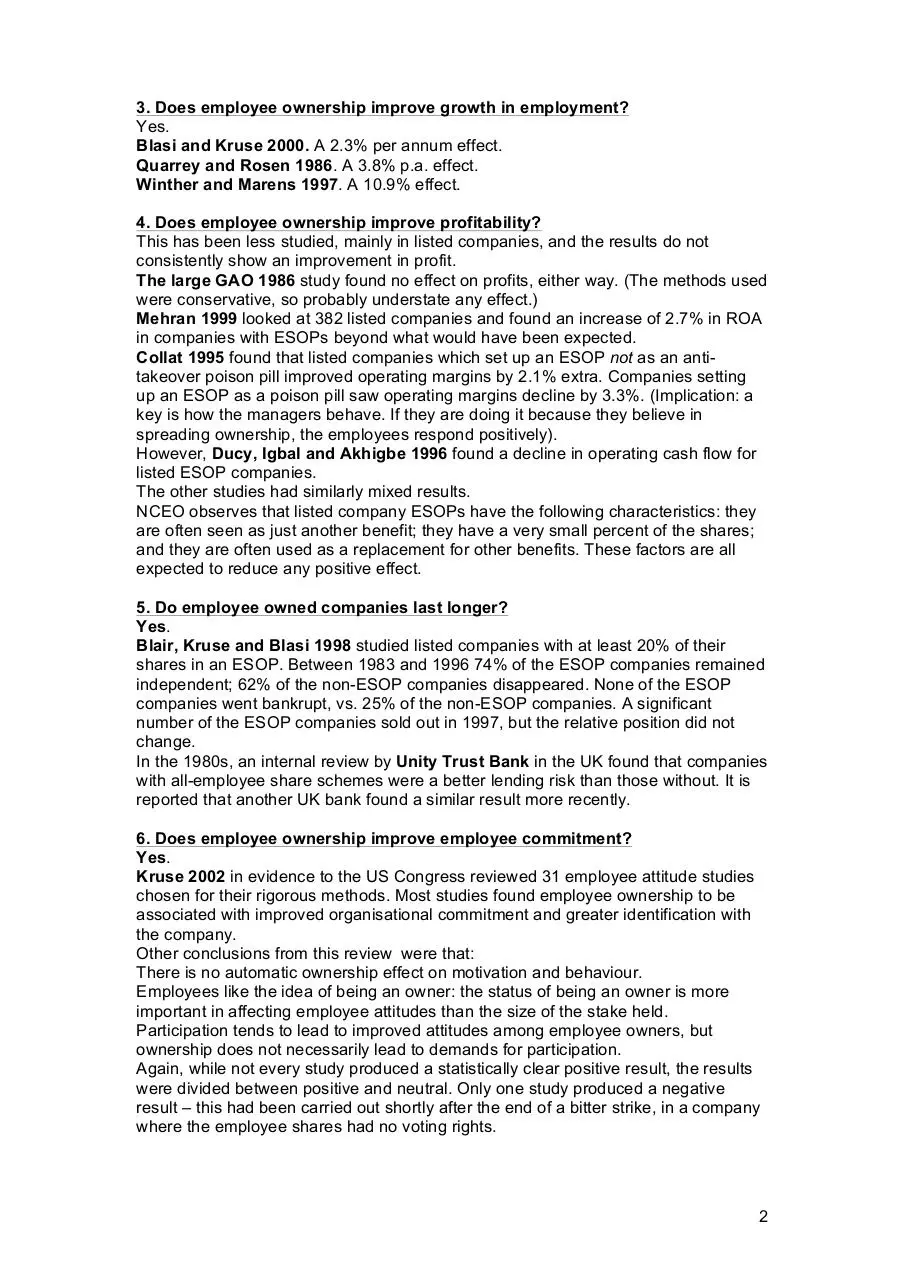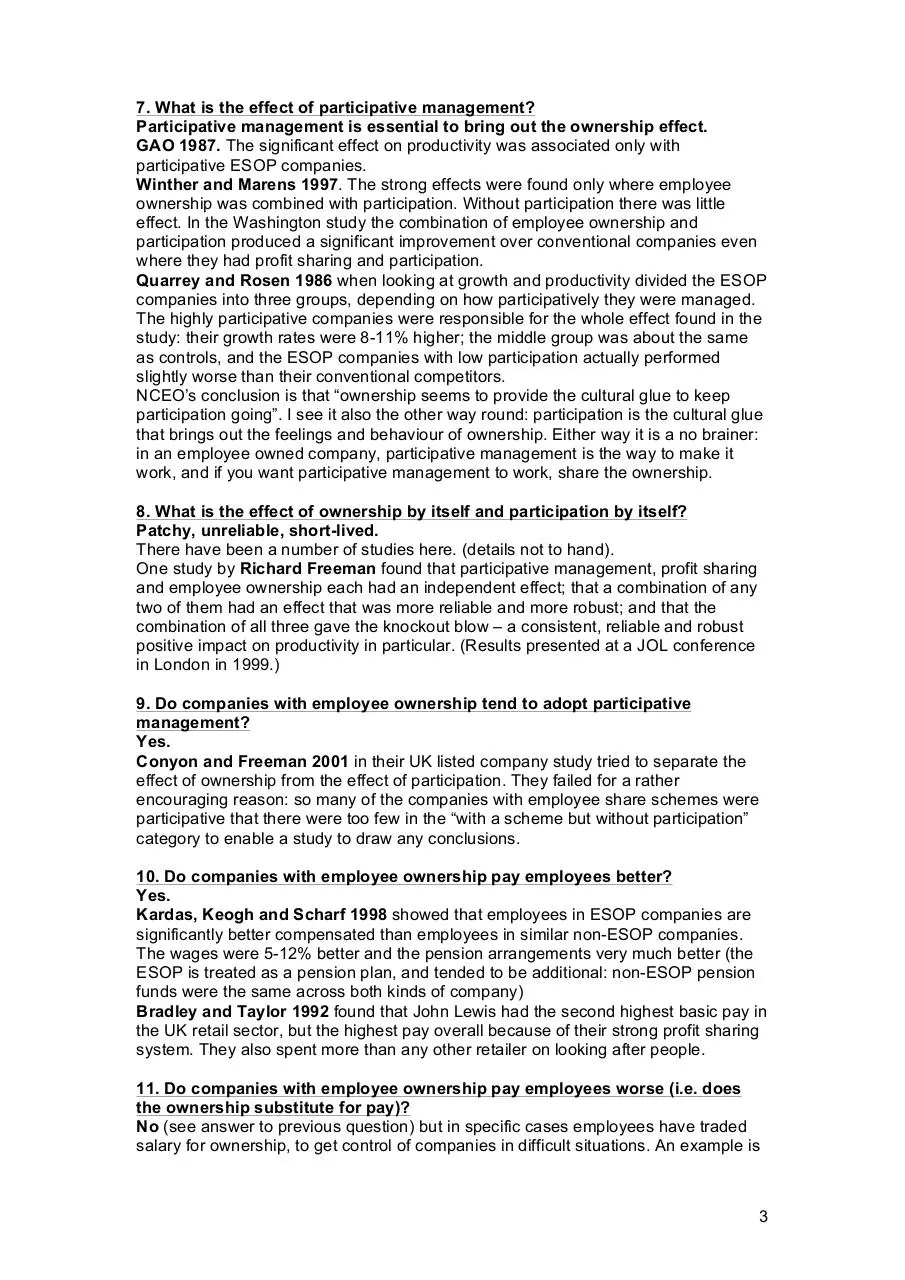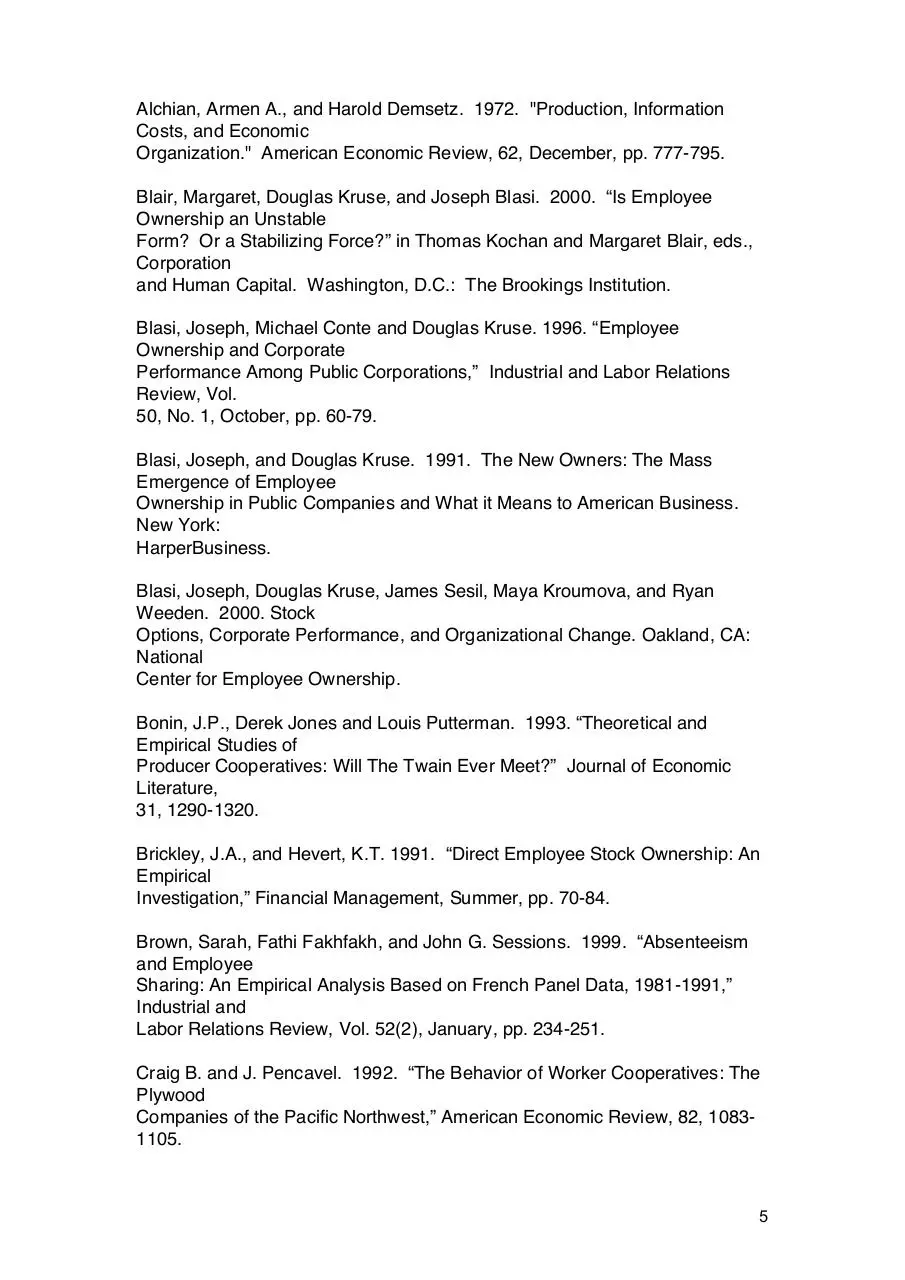EO Research by question (1) (PDF)
File information
Title: EO Research by question
Author: David Erdal
This PDF 1.3 document has been generated by Word / Mac OS X 10.8.5 Quartz PDFContext, and has been sent on pdf-archive.com on 06/10/2015 at 03:34, from IP address 2.120.x.x.
The current document download page has been viewed 573 times.
File size: 123.94 KB (8 pages).
Privacy: public file





File preview
Research Questions in Employee Ownership.
This paper, written for the lay person, arranges some research references under the
questions they answered. I have referred only to studies which are agreed to be well
designed. The studies whose designs have been criticised for statistical or
methodological reasons also produce very similar results. This summary does not
pretend to be exhaustive, but has tried to reflect the results fairly.
I am particularly grateful to Richard Freeman and Douglas Kruse for help in finding
studies, and to the NCEO website for their useful summary, on which this has
shamelessly drawn. The doubtless numerous errors and infelicities are mine.
1. Does employee ownership improve productivity?
Yes, absolutely without doubt. But only reliably when it is combined with
participative management (see question 7 below).
Over 70 empirical studies have been done. Key ones are:
Kruse and Blasi 1997. This meta-analysis of the data from 32 studies showed that
although a minority of studies failed to show a statistically significant link between
employee ownership and productivity, the result was very clear when the data were
combined: employee ownership is associated with improved productivity. None of the
results in any of the studies showed a negative effect. The average extra productivity
gain in ESOP companies was 4.4% a year, with ESOP companies being on average
over 6% more productive than equivalent non-ESOP companies.
Blasi and Kruse 2000. This study compared all ESOP companies on the large Dun
and Bradstreet US database with matched non-ESOP controls. In the three years
following the ESOP, sales per head grew on average by 2.3% p.a. more than would
have been predicted from pre-ESOP performance. (In this large study, the average
difference of 2.3% p.a. was very significant). With this difference sustained, after 10
years the average employee in an ESOP company will produce about 25% more
than in an initially identical non-ESOP competitor.
Conyon and Freeman 2001. This rigorous study of share schemes in 299 UK listed
companies showed a strong effect for manager share option schemes and an effect
over 40% greater still when the share ownership was widely distributed.
The GAO Study 1987. An independent controlled study by the General Accounting
Office of the US government, whose role was to test the rationale for tax breaks
given to ESOPs. They found a 52% improvement in productivity growth with an
ESOP. i.e. if the company grew productivity at 3%, an ESOP would improve it to
4.5%.
Bradley and Taylor 1992 This study used economist techniques to study 17 years of
data from all the main UK retailers. Over this long period, employee-trust-owned
John Lewis had the highest marginal labour productivity and the highest marginal
capital productivity.
2. Does employee ownership improve growth in sales?
Yes.
Quarrey and Rosen 1986. The first study. Looked at performance 5 years before
and after the introduction of an ESOP relative to competitors. (This design removed
extraneous market effects).
Blasi and Kruse 2000. A 2.4% per annum effect.
Winther and Marens 1997 (two studies, one of 25 ESOP companies in NY and one
of 28 companies in Washington). Sales grew on average 6% faster than expected in
the NY ESOP companies. The effects were differently measured in Washington, with
similar results.
1
3. Does employee ownership improve growth in employment?
Yes.
Blasi and Kruse 2000. A 2.3% per annum effect.
Quarrey and Rosen 1986. A 3.8% p.a. effect.
Winther and Marens 1997. A 10.9% effect.
4. Does employee ownership improve profitability?
This has been less studied, mainly in listed companies, and the results do not
consistently show an improvement in profit.
The large GAO 1986 study found no effect on profits, either way. (The methods used
were conservative, so probably understate any effect.)
Mehran 1999 looked at 382 listed companies and found an increase of 2.7% in ROA
in companies with ESOPs beyond what would have been expected.
Collat 1995 found that listed companies which set up an ESOP not as an antitakeover poison pill improved operating margins by 2.1% extra. Companies setting
up an ESOP as a poison pill saw operating margins decline by 3.3%. (Implication: a
key is how the managers behave. If they are doing it because they believe in
spreading ownership, the employees respond positively).
However, Ducy, Igbal and Akhigbe 1996 found a decline in operating cash flow for
listed ESOP companies.
The other studies had similarly mixed results.
NCEO observes that listed company ESOPs have the following characteristics: they
are often seen as just another benefit; they have a very small percent of the shares;
and they are often used as a replacement for other benefits. These factors are all
expected to reduce any positive effect.
5. Do employee owned companies last longer?
Yes.
Blair, Kruse and Blasi 1998 studied listed companies with at least 20% of their
shares in an ESOP. Between 1983 and 1996 74% of the ESOP companies remained
independent; 62% of the non-ESOP companies disappeared. None of the ESOP
companies went bankrupt, vs. 25% of the non-ESOP companies. A significant
number of the ESOP companies sold out in 1997, but the relative position did not
change.
In the 1980s, an internal review by Unity Trust Bank in the UK found that companies
with all-employee share schemes were a better lending risk than those without. It is
reported that another UK bank found a similar result more recently.
6. Does employee ownership improve employee commitment?
Yes.
Kruse 2002 in evidence to the US Congress reviewed 31 employee attitude studies
chosen for their rigorous methods. Most studies found employee ownership to be
associated with improved organisational commitment and greater identification with
the company.
Other conclusions from this review were that:
There is no automatic ownership effect on motivation and behaviour.
Employees like the idea of being an owner: the status of being an owner is more
important in affecting employee attitudes than the size of the stake held.
Participation tends to lead to improved attitudes among employee owners, but
ownership does not necessarily lead to demands for participation.
Again, while not every study produced a statistically clear positive result, the results
were divided between positive and neutral. Only one study produced a negative
result – this had been carried out shortly after the end of a bitter strike, in a company
where the employee shares had no voting rights.
2
7. What is the effect of participative management?
Participative management is essential to bring out the ownership effect.
GAO 1987. The significant effect on productivity was associated only with
participative ESOP companies.
Winther and Marens 1997. The strong effects were found only where employee
ownership was combined with participation. Without participation there was little
effect. In the Washington study the combination of employee ownership and
participation produced a significant improvement over conventional companies even
where they had profit sharing and participation.
Quarrey and Rosen 1986 when looking at growth and productivity divided the ESOP
companies into three groups, depending on how participatively they were managed.
The highly participative companies were responsible for the whole effect found in the
study: their growth rates were 8-11% higher; the middle group was about the same
as controls, and the ESOP companies with low participation actually performed
slightly worse than their conventional competitors.
NCEO’s conclusion is that “ownership seems to provide the cultural glue to keep
participation going”. I see it also the other way round: participation is the cultural glue
that brings out the feelings and behaviour of ownership. Either way it is a no brainer:
in an employee owned company, participative management is the way to make it
work, and if you want participative management to work, share the ownership.
8. What is the effect of ownership by itself and participation by itself?
Patchy, unreliable, short-lived.
There have been a number of studies here. (details not to hand).
One study by Richard Freeman found that participative management, profit sharing
and employee ownership each had an independent effect; that a combination of any
two of them had an effect that was more reliable and more robust; and that the
combination of all three gave the knockout blow – a consistent, reliable and robust
positive impact on productivity in particular. (Results presented at a JOL conference
in London in 1999.)
9. Do companies with employee ownership tend to adopt participative
management?
Yes.
Conyon and Freeman 2001 in their UK listed company study tried to separate the
effect of ownership from the effect of participation. They failed for a rather
encouraging reason: so many of the companies with employee share schemes were
participative that there were too few in the “with a scheme but without participation”
category to enable a study to draw any conclusions.
10. Do companies with employee ownership pay employees better?
Yes.
Kardas, Keogh and Scharf 1998 showed that employees in ESOP companies are
significantly better compensated than employees in similar non-ESOP companies.
The wages were 5-12% better and the pension arrangements very much better (the
ESOP is treated as a pension plan, and tended to be additional: non-ESOP pension
funds were the same across both kinds of company)
Bradley and Taylor 1992 found that John Lewis had the second highest basic pay in
the UK retail sector, but the highest pay overall because of their strong profit sharing
system. They also spent more than any other retailer on looking after people.
11. Do companies with employee ownership pay employees worse (i.e. does
the ownership substitute for pay)?
No (see answer to previous question) but in specific cases employees have traded
salary for ownership, to get control of companies in difficult situations. An example is
3
United Airlines, when their competitors such as Pan Am were going bust. Reduction
in pay and benefits kept the company alive, and gave the union-led buyout 55% of
the shares in return. At first they and their outside shareholders did very well;
however, continuing crisis in the industry, the effects of 9.11 (where two UA planes
were involved) and a failure to develop an ownership culture, together necessitated
refinancing and the employee stake fell to about 20%.
Several union led steel company buyouts in the US in the 1980s were also financed
by salary sacrifice.
UBHI is another example, successful in that it restarted a dead company that is
profitable after 8 years.
12. Does employee ownership increase returns for outside shareholders?
Seems to.
Kruse, Blasi and Conte followed the ‘employee ownership index’ (an index of share
prices in listed companies with 10% or more of their shares in an ESOP) for many
years starting in 1992. It outperformed the general index significantly. In 1997 the
EOI was up 193%, the Dow 145% and the S&P 140%. A similar index in the UK
(designed and run by Nigel Mason’s Capital Strategies) also outperformed the stock
exchange, but was less representative in its make-up.
13. Does majority employee ownership produce a stronger effect than minority
ownership?
This has not been widely studied, but from the single result so far, the answer
is yes.
Winther and Marens 1997 found that the strong effects they found were even better
in the companies with majority employee ownership.
14. What does the stock market think?
Having an employee stake is good.
95 of the largest UK listed companies have one or more all-employee share scheme,
which implies that it is now seen as a ‘must have’ benefit for recruitment.
Mehran 1999 found that 60% of the 382 listed companies he examined saw an
increase in their share price in the two-day period following the announcement of
their ESOP.
David Erdal
Baxi Partnership Limited
david@erdal.net
June 2006
4
Alchian, Armen A., and Harold Demsetz. 1972. "Production, Information
Costs, and Economic
Organization." American Economic Review, 62, December, pp. 777-795.
Blair, Margaret, Douglas Kruse, and Joseph Blasi. 2000. “Is Employee
Ownership an Unstable
Form? Or a Stabilizing Force?” in Thomas Kochan and Margaret Blair, eds.,
Corporation
and Human Capital. Washington, D.C.: The Brookings Institution.
Blasi, Joseph, Michael Conte and Douglas Kruse. 1996. “Employee
Ownership and Corporate
Performance Among Public Corporations,” Industrial and Labor Relations
Review, Vol.
50, No. 1, October, pp. 60-79.
Blasi, Joseph, and Douglas Kruse. 1991. The New Owners: The Mass
Emergence of Employee
Ownership in Public Companies and What it Means to American Business.
New York:
HarperBusiness.
Blasi, Joseph, Douglas Kruse, James Sesil, Maya Kroumova, and Ryan
Weeden. 2000. Stock
Options, Corporate Performance, and Organizational Change. Oakland, CA:
National
Center for Employee Ownership.
Bonin, J.P., Derek Jones and Louis Putterman. 1993. “Theoretical and
Empirical Studies of
Producer Cooperatives: Will The Twain Ever Meet?” Journal of Economic
Literature,
31, 1290-1320.
Brickley, J.A., and Hevert, K.T. 1991. “Direct Employee Stock Ownership: An
Empirical
Investigation,” Financial Management, Summer, pp. 70-84.
Brown, Sarah, Fathi Fakhfakh, and John G. Sessions. 1999. “Absenteeism
and Employee
Sharing: An Empirical Analysis Based on French Panel Data, 1981-1991,”
Industrial and
Labor Relations Review, Vol. 52(2), January, pp. 234-251.
Craig B. and J. Pencavel. 1992. “The Behavior of Worker Cooperatives: The
Plywood
Companies of the Pacific Northwest,” American Economic Review, 82, 10831105.
5
-----. 1993. “The Objectives of Worker Cooperatives,” Journal of Comparative
Economics,
Vol. 17(2), June, pp. 288-308.
-----. 1995. “Participation and Productivity: A Comparison of Worker
Cooperatives and
Conventional Firms in The Plywood Industry,” Brookings Papers on
Economic Activity,
212-160.
Estrin, Saul, and Derek C. Jones. 1992. “The Viability of Employee-Owned
Firms: Evidence
from France,” Industrial & Labor Relations Review, Vol. 45 (2). p 323-38,
January.
Gates, Jeffrey R. 1998. The Ownership Solution: Toward a Shared Capitalism
for the 21st
Century, Addison-Wesley.
Grunberg, Leon, Sarah Moore, and Edward Greenberg. 1996. “The
Relationship of Employee
Ownership and Participation to Workplace Safety,” Economic and Industrial
Democracy,
Vol. 17(2), May, pp. 221-241.
Kardas, Peter; Adria L. Scharf; and Jim Keogh. 1998. “Wealth and Income
Consequences of
ESOPs and Employee Ownership: A Comparative Study from Washington
State,"
Journal of Employee Ownership Law and Finance. Vol. 10, No. 4, Fall.
Keef, Stephen P. 1998. “The Causal Association between Employee Share
Ownership and
Attitudes: A Study Based on the Long Framework,” British Journal of Industrial
Relations, Vol. 36(1), March, pp. 73-82.
Kruse, D. 1984. Employee Ownership and Employee Attitudes: Two Case
Studies. Norwood,
PA: Norwood Editions.
-----. 1993. Profit Sharing: Does It Make A Difference? Kalamazoo, MI: W.E.
Upjohn Institute
for Employment Research.
-----. 1996. “Why Do Firms Adopt Profit-Sharing and Employee Ownership
Plans?” British
Journal of Industrial Relations, Vol. 34, No. 4, December 1996, pp. 515-38.
-----, and Joseph Blasi. 1997. "Employee Ownership, Employee Attitudes,
and Firm
6
Performance: A Review of the Evidence," in The Human Resources
Management
Handbook, Part 1. Edited by David Lewin, Daniel J.B. Mitchell, and Mahmood
A. Zaidi.
Greenwich, CT.: JAI Press.
-----. 1999. “Public Opinion Polls on Employee Ownership and Profit
Sharing,” Journal of
Employee Ownership Law and Finance, Vol. 11, No. 3, pp. 3-25.
Logue, John, and Jacquelyn Yates. 2001. The Real World of Employee
Ownership. Ithaca,
NY: Cornell University Press.
McNabb, Robert, and Keith Whitfield. 1998. “The Impact of Financial
Participation and
Employee Involvement on Financial Performance,” Scottish Journal of Political
Economy, Vol. 45(2), May, pp. 171-187.
Nalbantian, Haig, ed. 1987. Incentives, Cooperation, and Risk Sharing.
Totowa, N.J.: Rowman
and Littlefield.
Ohkusa, Yasushi, and Fumio Ohtake. 1997. “The Productivity Effects of
Information Sharing,
Profit Sharing, and ESOPs,” Journal of the Japanese and International
Economies, Vol.
11(3), September, pp. 385-402.
Pendleton, Andrew, Nicholas Wilson, and Mike Wright. 1998. “The
Perception and Effects of
Share Ownership: Empirical Evidence from Employee Buy-outs,” British
Journal of
Industrial Relations, Vol. 36(1), March, pp. 99-123.
Pliskin, Jeffrey, Takao Kato, and Derek Jones. 1997. "Profit Sharing and
Gain Sharing: A
Review of Theory, Incidence and Effects," in The Human Resources
Management
Handbook, Part 1. Edited by David Lewin, Daniel J.B. Mitchell, and Mahmood
A. Zaidi.
Greenwich, CT.: JAI Press.
Putterman, Louis, and G. Skillman. 1988. "The incentive effects of monitoring
under alternative
compensation schemes," International Journal of Industrial Organization, pp.
109-119.
Quarrey, M., & Rosen, C. 1993. Employee Ownership and Corporate
Performance. Oakland,
7
CA: National Center for Employee Ownership.
Scharf, Adria, and Christopher Mackin. 2000. "Census of Massachusetts
Companies with
Employee Stock Ownership Plans (ESOPs)." Boston: Commonwealth
Corporation.
Sesil, James, Maya Kroumova, Douglas Kruse, and Joseph Blasi.
Forthcoming. “Broad-based
Employee Stock Options in U.S. ‘New Economy’ Firms,” British Journal of
Industrial
Relations.
Smith, Stephen, Beom-Cheol Cin, and Milan Vodopivec. 1997. “Privatization
Incidence,
Ownership Forms, and Firm Performance: Evidence from Slovenia,” Journal
of
Comparative Economics, Vol. 25(2), October, pp. 158-179.
U.S. Bureau of Labor Statistics. 2000. “Pilot Survey on the Incidence of
Stock Options in
Private Industry in 1999,” News Release USDL 00-290, October 10.
U.S. Department of Labor. 2001. 2001 Report on the American Workforce.
Washington, D.C.:
U.S. Department of Labor.
U.S. Senate, Subcommittee of the Committee on Finance. 1939. “Survey of
Experiences in
Profit Sharing and Possibilities of Incentive Taxation.” Washington, D.C.:
Government
Printing Office.
Weiss, Andrew. 1987. "Incentives and Worker Behavior," in Haig
Nalbantian, ed., Incentives,
Cooperation, and Risk Sharing. Totowa, N.J.: Rowman and Littlefield, pp.
137-150.
Winther, Gorm, and Richard Marens. 1997. “Participatory Democracy May
Go A Long Way:
Comparative Growth Performance of Employee Ownership Firms in New York
and
Washington States,” Economic and Industrial Democracy, Vol. 18(3), August,
pp. 393422.
8
Download EO Research by question (1)
EO Research by question (1).pdf (PDF, 123.94 KB)
Download PDF
Share this file on social networks
Link to this page
Permanent link
Use the permanent link to the download page to share your document on Facebook, Twitter, LinkedIn, or directly with a contact by e-Mail, Messenger, Whatsapp, Line..
Short link
Use the short link to share your document on Twitter or by text message (SMS)
HTML Code
Copy the following HTML code to share your document on a Website or Blog
QR Code to this page

This file has been shared publicly by a user of PDF Archive.
Document ID: 0000305961.